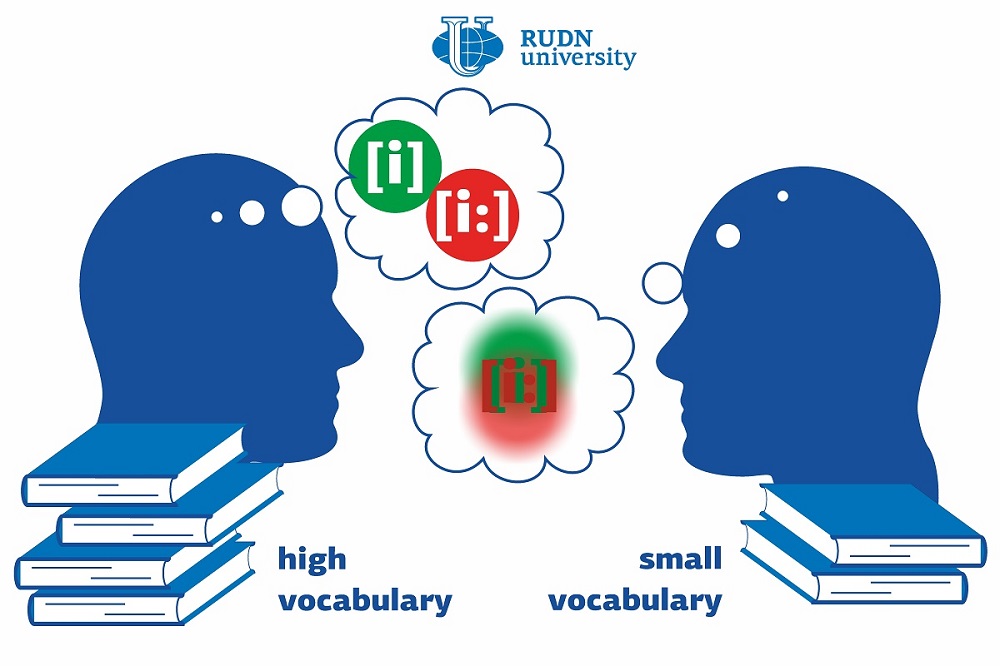Vocabulary Size Affects One’s Ability to Differentiate Between Vowels in a Foreign Language, Say Linguists from RUDN University
The results of the study were published in the Language Learning and Development journal.
In linguistics, a second language (or L2) is any language that a person acquires after their mother tongue. The first language, or L1, affects the use of the second one: for example if L1 does not have many variations of vowel pronunciation, and L2 is rich in them, it would be more difficult for a speaker to perceive and reproduce the vowel sounds of the second language. It can be hard for a native Spanish speaker to feel the difference between the sounds [i] and [i:] in English because in Spanish only [i] is used. A team of linguists from RUDN University studied the effect of L2 vocabulary size on the speakers’ ability to tell the difference between L2 vowel sounds.
“For our study, we chose Russian and English languages, because the former contains only five vowel sounds while the latter has a complex system of vowels. Therefore, we assumed that it would be difficult for Russian speakers to differentiate between English vowels,” said Georgios Georgiou, Ph.D., a postdoc, and a researcher at the Department of General and Russian Linguistics, Philological Faculty of RUDN.
To describe vowel sounds, scientists use a set of parameters called formants. They indicate vibration frequency and are measured in hertz. Based on the values of formants, a linguist can understand how a human tongue moves when a vowel sound is pronounced. For example, the first formant shows the height of the tongue in the mouth and the second indicates its proximity to teeth. Russian language (L1) has five vowel phonemes ( [i, e, a, o, u]), and English (L2)—11. The team placed L1 and L2 vowel sounds on a reference plane and marked the values of the first and the second formant on the axes. When a set of points was created on the plane, the team measured the distance between them and used it as an indicator of differences between the sounds. Based on the measured distances, the team identified two English vowel pairs, [i:]/[I] and [e]/[ɜː], that were the easiest to differentiate from one another. Then, an experiment was conducted to confirm this hypothesis and to study the correlation between differentiation abilities and vocabulary size.
The team chose 28 Russian-speaking students from 17 to 19 years of age. All of them spent eight years on average studying English (RP) at public or language schools and never lived in an English-speaking country for more than a month. Their English proficiency level was B2, and their proficiency in any other foreign language did not exceed A2. The participants were divided into two groups with small (around 5,500 words) and large (7,150 words) vocabulary based on the results of an online test with multiple-choice questions. In the test, the participants were asked to choose the correct definitions of English words, which gave the researchers an understanding of their average vocabulary size. After that, both groups took a psychoacoustic test that consisted of two parts. First, the students listened to English words and matched the vowels in them with the vowels of their native language. Then, they listened to groups of three words and had to identify whether the vowel in the second word matched that in the first or the third word.
It turned out that one’s ability to associate L2 vowels with the vowels of one’s mother tongue does not depend on their vocabulary. The participants with a small vocabulary managed to match Russian and English sounds in 95% of cases and students with a large vocabulary—in 94.7% of cases. However, the vocabulary size affected the participants’ ability to tell the difference between vowels in similar words. For example, students with a large vocabulary differentiated between [ɪ] and [iː] in 71% of cases, and the participants from the other group—only in 59%.
“In the future, we plan to study the effect of additional external factors, such as fluency in another foreign language, on the differentiation of L2 sounds,” added Georgios Georgiou.
The results of the study were published in the Language Learning and Development journal.
Products derived from microalgae represent a cutting-edge development in the field of bioeconomy. The potential of this biological resource was discussed at the international research seminar “Foundations for a Green Sustainable Energy”, part of the BRICS Network University’s thematic group on “Energy”. The event was organized by the Institute of Ecology at RUDN University.
Ambassadors of Russian education and science met at a conference in RUDN University to discuss how they can increase the visibility of Russian universities and research organizations in the world, and attract more international students in Russia.
The international scientific seminar hosted by RUDN Institute of Ecology “Experience of participation in student organizations as a way to form career skills” united scholarship recipients of the International Student Mobility Awards 2024 and Open Doors, along with members of the scientific student society “GreenLab” and the professional student association “Kostyor (Bonfire)” shared their projects focused on environmental protection.
